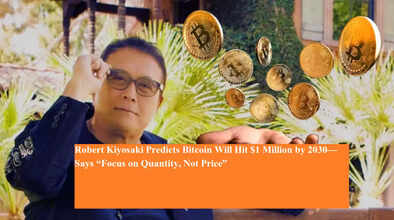Robert Kiyosaki Predicts Bitcoin Will Hit $1 Million by 2030—Says “Focus on Quantity, Not Price”

Renowned author of Rich Dad Poor Dad, Robert Kiyosaki, has once again stirred conversations in the financial world with a bold prediction about Bitcoin. According to him, the world’s most talked-about cryptocurrency could soar to $1 million per coin by 2030. But his message to investors isn’t just about skyrocketing prices—it’s about shifting your mindset from short-term price tracking to long-term asset accumulation.
Bitcoin at $1 Million? Kiyosaki Thinks It’s Possible
In a recent social media post, Kiyosaki expressed strong belief in Bitcoin's long-term potential. He wrote, “Poor people focus on prices. Rich people focus on how many assets they own.” This statement captures his investment philosophy—accumulate assets consistently over time, rather than panic over daily price movements.
Kiyosaki shared that he first bought Bitcoin when it was priced at around $6,000 per coin, acquiring as much as he could. While he regrets not buying more back then, he blamed “fake money”—his term for fiat currency—for holding him back. In his view, fiat money is controlled heavily by governments and central banks, making it susceptible to inflation and depreciation.
Why Kiyosaki Prefers “Hard Assets” Like Bitcoin, Gold & Silver
Robert Kiyosaki is a long-time critic of fiat currency. He has frequently warned against putting too much trust in traditional money systems that are prone to manipulation and economic downturns. Instead, he recommends investing in tangible, inflation-resistant assets such as:
-
Bitcoin
-
Gold
-
Silver
His belief is that these assets can act as a financial shield during uncertain economic times.
In his post, he reiterated this point, saying that what matters most is not how high or low an asset’s price is today—but how much of that asset you actually own. For long-term investors, this mindset shift can be powerful: stop obsessing over market fluctuations, and instead aim to gradually build ownership of quality assets.
Not the First Bold Forecast
This isn’t the first time Kiyosaki has made eye-catching predictions. In April 2025, he forecast that by 2035:
-
Bitcoin could exceed $1 million
-
Gold might reach $30,000 per ounce
-
Silver could rise to $3,000 per coin
While some see these figures as overly ambitious, Kiyosaki maintains that economic instability, rising inflation, and central bank interventions make these outcomes increasingly plausible.
Divided Opinions in the Market
Kiyosaki's predictions have sparked debates across the investor community. While many support his long-term bullish stance on Bitcoin and other hard assets, others are skeptical. Detractors point to the unpredictable nature of crypto markets, regulatory hurdles, and rapidly evolving technology as reasons to be cautious.
Critics argue that forecasting such high prices ignores potential risks like:
-
Stringent government regulations
-
Technological disruption
-
Security concerns in digital wallets and exchanges
-
Volatility and lack of widespread adoption in developing economies
Yet Kiyosaki remains undeterred. He encourages investors to take control of their financial future through strategic accumulation of real assets, rather than depending on systems he deems unstable.
What This Means for Everyday Investors
Whether or not Bitcoin reaches the $1 million mark, Kiyosaki’s message is worth considering. His emphasis is not on chasing returns or timing the market, but on developing financial discipline, long-term vision, and ownership of reliable assets. For everyday investors, it’s a call to rethink priorities:
-
Stop checking prices obsessively.
-
Focus on building a portfolio of high-potential, long-term assets.
-
Hedge against inflation and economic uncertainty.
Conclusion
Robert Kiyosaki’s prediction that Bitcoin could hit $1 million by 2030 might seem outrageous to some, but it reflects a growing sentiment among financial thinkers: that the world is moving away from fiat dependence and toward decentralized, inflation-resistant assets. Whether you agree with him or not, his advice offers a timeless principle: True wealth lies not in price speculation, but in strategic accumulation.

